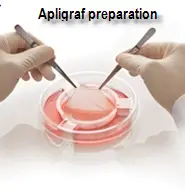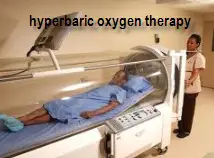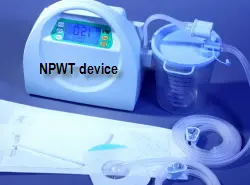AUTHOR: Marc Mitnick DPM home --> wound care --> wound treatments
ADVANCED WOUND CARE TREATMENTS
SKIN SUBSTITUTES AND SKIN GRAFTS
If you happen to be one of those patients who is starting to become disenchanted because your wound is not closing, I think it is safe to say your doctor is also frustrated. All is not lost. In addition to the dressings we have already discussed there is a group of advanced dressings known as biological dressings. (At some point in this article, it should be mentioned that any ulcer which has failed to heal in an acceptable period of time, should be biopsied to make sure there is no malignancy). These are essentially known as skin substitutes. They are produced from human and animal tissue. Their purpose is to create granulation (healing within the base of the ulcer) and epithelization (closing of the wound from the outside border inward). If the wound is not closing properly then there are coverings which can be placed over the wound to actually promote healing. In order to use these types of dressings there are certain obstacles that have to be hurdled.
The first is cost. These dressings are extremely expensive and unfortunately if you have insurance which will not cover the cost, nor are you in a position to pay out of pocket for the dressings, then this approach may not even be an option for you. There is even a question about cost versus efficacy. In other words, if the dressing works to close the wound then the cost was certainly worth it, however, if the wound still fails to close then the argument can be made that a lot of money was wasted.

|
These dressings are applied according to certain protocols developed by the manufacturer and in almost all cases they are sent to the doctor's office in a refrigerated state, so they first have to be brought up to room temperature in a given period of time. The wounds have to be "prepared" in order to accept the dressing which in most cases is cut to a specific size, relative to the size of the wound. Patient compliance becomes even more important because this is not a simple case of "oops I walked on the foot and the dressing slid off".
The wound itself has to be regarded as a clean wound. This means that there is no visible or clinical sign of infection. If the wound is still draining excessively then that too precludes use of skin substitutes in most cases. The base of the wound must demonstrate some degree of beefy red granulation tissue. The types of wounds that are considered acceptable for skin substitutes include diabetic foot ulcers usually on the bottom of the foot, venous stasis ulcers, burns of partial to full thickness, pressure ulcers (non-diabetics) and for wounds secondary to post-operative complications.
Within the last couple of years (presently 2016) the use of amniotic membranes on ulcers has become increasing popular. The concept has been around for years, but until recently there had always been concern about harvesting and handling the membrane as well as transmission of disease. Recent scientific developments have yielded commercially available allografts (tissue derived from the same species).
Amniotic membrane is derived from women following cesarean delivery, with proper informed consent, and proper infectious disease screening as dictated by the Food and Drug Administration. Harvesting must also meet the criteria of the American Association of Tissue Banks.
Amniotic membrane tissue is privileged tissue and exhibits anti-inflammatory properties, includes a reservoir of multiple growth factors involved with tissue growth and tissue regeneration, as well as dermal fibroblast proliferation and stem cell production. Amniotic membrane also exhibits the ability to promote angiogenesis or increased blood flow. All of these properties certainly help the developing fetus grow, but these same properties help repair ulcers and other wounds.
The limited number of studies performed up to this point have been nothing short of sensational in terms of getting wounds closed in a faster more timely manner then other treatment options. Further, larger studies are needed to confirm the findings on these initial studies.
Certainly at this point, someone reading this article is wondering why not just perform split thickness skin grafts to close a wound as opposed to the skin substitutes. The choice to use skin grafting or skin substitutes depends on a number of factors including the overall health of the patient as skin grafting creates a second surgical wound on the body and the patient may not be a good candidate for additional surgery. A debilitated patient would include those that exhibit neuropathy, peripheral artery disease elevated blood sugars, nutritionally deprived, hypertension and coronary artery disease.
HYPERBARIC OXYGEN
One of the theories as to why some wounds do not heal is that there is not enough oxygen in the wound itself. Oxygen is a necessary component to wound healing. Studies have shown that wounds deprived of oxygen will not heal, but when oxygen is added to the mix wounds show a greater tendency to close. The exposure to additional oxygen has to come from within the body, so just applying oxygen to the wound will have no affect.
Hyperbaric oxygen therapy is a treatment where the patient breathes 100 percent oxygen at a greater than normal pressure. There can be as many as 15-30 treatments each lasting between 1-2 hours. These treatments may occur once or twice a day. The treatment occurs within an enclosed chamber. This treatment essentially increases the concentration of oxygen in the blood and of course blood brings the oxygen to the wound.

|
Hyperbaric oxygen has some other positive effects as well. It decreases local edema (swelling and edema can delay healing). The increased oxygen tension also kills local bacteria, increases growth factors within the wound and increases the flexibility of red blood cells enabling them to get deeper into the wound.
Having said all of that, there are pundits out there who downplay the effects of hyberbaric oxygen. The problem has been due to a lack of qualified studies on the subject since the initial trial in 1987. Subsequent studies have not been well controlled and have involved small samples of patients with varying treatment protocols.
There are some potential side effects to hyperbaric oxygen including damage to the ears (2-4%) and lungs, particularly pneumothorax (<2%). Patients should have a chest x-ray prior to initiation of this therapy. Additionally, worsening of myopia, generalized seizures, upper respiratory infections and claustrophobia have also been reported.
Keep in mind that hyperbaric oxygen is not a stand alone procedure but one which is done in conjunction with continued local wound care. In most cases this treatment is reserved for deeper wounds where tendon and/or bone is exposed and involved.
Hyperbaric oxygen therapy may also be used for the treatment of gas gangrene and progressive necrotizing infections along with debridement of the wound and antibiotic therapy.
Hyperbaric oxygen therapy may also be used post skin graft and skin flap procedures where there is concern the graft may not hold.
Additional condition which may be treated with hyperbaric oxygen include osteomyelitis and acute thermal burn injury.
NEGATIVE PRESSURE WOUND THERAPY (NPWT)
Negative pressure wound therapy is indicated in the treatment of acute and chronic wounds along with traumatic wounds. It can also be used on skin grafts to help promote their healing. NPWT has been in use for around 20 years. What this procedure does is to increase the pressure below the surface of the wound in an effort to help heal difficult wounds. One of the advantages of this therapy is that it increases the blood flow to the ulcer site and as we have already discussed, increased blood flow is necessary to deliver nutrients and oxygen to the ulcer site in order to help it close. In addition NPWT also helps promote the formation of granulation tissue, reduces the bacterial count in the wound, helps remove excess drainage and infectious materials, proper wound temperature, and restores moisture balance to the wound since a moist wound (not to be confused with a draining wound) is the ideal environment needed to promote wound healing.

|
The increased pressure is delivered by a foam dressing which is covered by an adhesive drape which forms an airtight seal over the dressing, a drainage tube which is connected to a vacuum assisted closure device. Foam is used as the dressing because foam enables a uniform pressure to be applied to the whole wound. The negative pressure is applied either intermittantly or continuously over fifteen minute intervals. Some wound care centers have even tried infusing insulin and the antibiotic doxycycline in an effort to enhance their results.
Other advanced wound healing techniques that are gaining acceptance include the use of lasers, shockwave and ultrasound therapy, as well as platelet therapy and stem cell therapy. So, hopefully what you have learned from reading this article is that wound healing is a very complex procedure and there is no one protocol for treatment. Each wound or ulcer has to be evaluated on an independent basis along with the overall medical status of the patient. All wound care does require ongoing surgical treatment of the wound, but the decision to employ other modalities rests with your doctor and in the majority of the cases is based on how well the healing process is progressing.
once the wound is healed
It is very important for those of you reading this who happen to be wound or ulcer patients that closing the wound is only half the battle. Once closed, there is also the issue of keeping the wound closed and not recurring. Obviously, in a traumatic wound or even a decubitus ulcer on the heel, the same "perfect storm" will probably not occur again. It is with wounds and ulcers on the bottom of the foot that the real issue of recurrence that has to be addressed.
This will usually require a lifestyle change on the part of the patient. The most important part is education. The patient needs to become educated on how the original wound developed and what to do to avoid the same problem all over again. This will generally include actual inspection of the foot/feet on a daily basis by either the patient or a family member. It will also require regular visits to the podiatrist for ongoing foot care.
Modification in diet, better control of blood sugars, adequate blood flow to the feet will all need to be addressed and regulated. Shoe modification is an integral part of the ongoing process. Shoes with an innersole that distributes body weight more evenly throughout the foot and takes pressure off the original wound site is mandatory.
Failure to work with you doctors on an ongoing basis will ultimately lead to the same problem recurring.
Points to take away from this article are the following:
- Wounds can take a long time to heal. Some never heal
- Adhering to the advice given by your doctors is mandatory
- Cheating in terms of walking on the wound, or not following your diet, or not taking your medication, will only delay healing
- There are many ways to treat a wound and most protocols are based on how the wound is progressing
see related article....cellulitis
REFERENCES
American Podiatric Medical Association
UPDATES TO WOUND CARE
11/27/2022 Preliminary research coming out of Stanford University has come up with a "smart" bandage to heal slow healing wounds, typical of which are diabetic wounds of the foot.
The dressing is made up of two components, the bottom portion which comes in contact with the wound is a hydrogel (which is presently found in many wound dressings), while the top portion of the dressing is a very thin polymer which contains the electrical components. Sensors within the dressing continuously monitor the wounds temperature and electrical impedance. As a wound is healing the temperature will begin to diminish because of a reduction in inflammation, while the electrical impedance increases as the wound heals.
If these metrics reveal that a given wound is not healing, then the dressing gives off an electrical stimulation which is intended to promote healing.
So far testing has only been done on mice. Recalibration is necessary in order to be used on human tissue. But, this is another example of technology solving an age old problem.
12/05/2022 The centers for Medicare and Medicaid Services has a made a preliminary recommendation to establish a billing code (HCPCS) for an advanced wound care system developed by Arch Therapeutics. The novelty of this product for partial and full thickness wounds is synthetic self assembling peptide matrix made of a proprietary peptide synthesized from natural occurring amino acids.
Upon exposure to ions in the wound, the peptide matrix self assembles into a nanofiber network within the wound to provide a physical barrier to control infection and better regulate inflammation.
Additionally, the network forms an extracellular matrix that forms a "scaffold" to speed up tissue growth and tissue repair.
The product is easy to use in the office setting, requires no cold storage and readily encompasses irregular shaped wounds.
Want more information? CLICK HERE


Recent Articles
-
Vitamin D impact on health
Feb 06, 23 07:17 PM
Researchers are suggesting that the effectiveness of Vitamin D in fighting and preventing disease is predicated on a persons body mass index (BMI). The thinner the person the greater the positive impa… -
Foods to speed up healing
Feb 01, 23 02:41 PM
One of the best ways to help yourself heal faster after surgery is to eat well. Getting the proper nutrition will provide your body with the essentials it needs to promote healing. Here is a suggestio… -
Cancer and Type 2 Diabetes
Jan 25, 23 04:52 PM
An article revealing that older type 2 diabetics have a higher incidence of cancer then non-diabetics. It is suggested that cancer may surpass CVD as the number one cause of death in older diabetics. -
Does glucosamine or MSM reduce arthritis pain?
Jan 22, 23 01:41 PM
A good review of the possible benefits to taking glucosamine, chondroitin or MSM for arthritis. Always beware of the possible side effects of over the counter supplements. -
shin splints
Jan 18, 23 05:12 PM
A great review on the various causes of shin splints, along with treatment options. -
Whats new in skin cancer?
Jan 15, 23 08:32 PM
A presentation of newer skin protection combinations in an effort to better protect the skin from the hazards of sun exposure. -
Causes and risk factors of warts
Jan 14, 23 05:02 PM
A good review of the causes of warts and protective measures you can take to prevent developing them. -
Do chronic wounds need to be dressed daily?
Jan 11, 23 02:18 PM
Because of supply chain shortages as well as staffing shortages particularly during the pandemic, many institutions extended the time between dressing changes for chronic wounds. Is this really the be… -
Food choices that raise your risk of type 2 diabetes
Jan 08, 23 10:07 AM
A good review of how blood sugars can become elevated and the harm that can do. Certain food groups have a tendency to raise your blood sugars and should be avoided. -
Outcome stats from Scarf bunionectomy
Jan 03, 23 03:04 PM
The Journal of Foot and Ankle Surgery recently reported a meta analysis of outcomes in 1583 Scarf bunionectomies that met their inclusion criteria. Adverse events did not seem to be any better or wors…